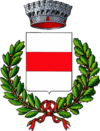Iulia Concordia
| Concordia Sagittaria | ||
|---|---|---|
| Comune | ||
| Comune di Concordia Sagittaria | ||

Cathedral of Concordia Sagittaria.
|
||
|
||
| Location of Concordia Sagittaria in Italy | ||
| Coordinates: 45°46′N 12°51′E / 45.767°N 12.850°E | ||
| Country | Italy | |
| Region | Veneto | |
| Province / Metropolitan city | Venice (VE) | |
| Frazioni | Cavanella, Paludetto, Sindacale, Teson | |
| Government | ||
| • Mayor | Marco Geromin | |
| Area | ||
| • Total | 66.50 km2 (25.68 sq mi) | |
| Elevation | 4 m (13 ft) | |
| Population (28 February 2007) | ||
| • Total | 10,708 | |
| • Density | 160/km2 (420/sq mi) | |
| Demonym(s) | Concordiesi | |
| Time zone | CET (UTC+1) | |
| • Summer (DST) | CEST (UTC+2) | |
| Postal code | 30023 | |
| Dialing code | 0421 | |
| Website | Official website | |
Concordia Sagittaria is a town and comune in the province of Venezia, Veneto, Italy.
The town was founded in 42 BC as Iulia Concordia by the Romans, where the Via Annia and the Via Postumia crossed each other. It was taken and destroyed by Attila in 452 AD.
After the fall of the Western Roman Empire it was part of the Lombard duchy of Cividale, and later was first in the March of Friuli and then in the Patriarchate of Aquileia.
In 1420, together with all Friuli, it was annexed by the Republic of Venice.
In 1838 it was separated from Friuli to be included in the province of Venice.
...
Wikipedia


